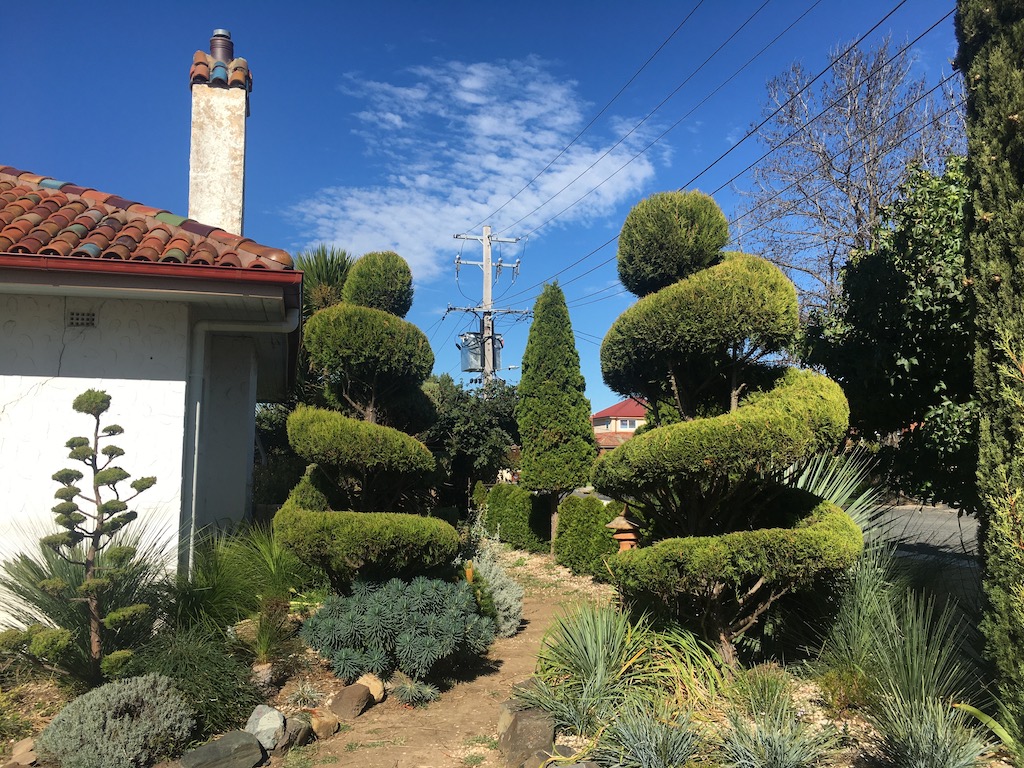
Dennis Spinks and Christine Bryan in the lobby of their home which retains much of its original charm. Photo: John Thistleton.
In the afterglow of buying an elegant old home these days, the scarcity and skills of tradies test the new owners’ enthusiasm.
Such has been the experience of heritage aficionados Christine Bryan and her husband Dennis Spinks, who bought “Villa Nevaeh”, a Spanish Mission-styled home on the corner of Murray and Kinghorne Streets, Goulburn.
After paying $360,000 in 2009 for the two-bedroom rendered brick home they have commissioned several reports, underpinned one corner of the house, replaced gutters and swallowed the bitterness of $13,000 spent on an unsuccessful rewiring exercise.
But in among those disasters sprang a delight, the discovery of two timber-framed sliding doors opening to the dining room, which had been pushed aside in a previous, ill-considered renovation.
That discovery rekindled Christine and David’s enthusiasm. They had met years earlier when Christine managed the historic Collingwood Home in Liverpool and Dennis managed an army engineer museum at Moorebank. They had various jobs subsequent to that and came to Goulburn in 2009 to be closer to Dennis’ two daughters.
While house hunting, they came to 1 Murray Street. “Having that background in heritage when I walked into it, I nearly died,” Christine said. “I just had to have it.
“I have always been a lover of Arts and Crafts-style buildings. For years we collected Arts and Crafts furniture, so when I walked in and saw this, it was amazing,” she said.

The current owners of Villa Nevaeh removed an overbearing cedar of Lebanon tree from their garden and continue nurturing and shaping it to complement the home’s Spanish Mission design. Photo: John Thistleton.
Maple timber panelling in the lobby, varnished doors, leadlight windows and the roof’s multi-coloured Spanish roofing tiles which also sit atop the chimneys are among other distinguishing features.
As well as maintaining the interior Spanish Mission style, Christine has shaped the garden to match, shaping the trees with topiary hedging and planting cactus.
Christine and Dennis now plan to repair the interior plaster, return to using the little kitchen nook which is now occupied by a fridge, and extend out the back.
Perhaps the most treasured finds since their arrival are the stories of previous owners which came to light from Christine’s tireless research. The archivist, librarian and historian has scoured records and uncovered the land’s allotment back in 1838. She found records of the area’s first substantial home, “Bindagundra“, designed by EC Manfred and families who shaped the neighbourhood including the Murrays, Codys, and Butterworths.
Her timeline leads to 1928 when the Bindagundra subdivision was approved. Joint owners were William Murray and Emily Murray who operated a drapery store in Goulburn.
Sometime between 1929 and 1930 Tom Cody, the son of a prominent Goulburn builder, John Cody, who owned a timber and joinery business in Auburn Street, built Villa Nevaeha. Christine said the home was more than likely designed by Tom Cody’s brother, Vincent de Paul Travis Cody, an architect in Sydney and later in Goulburn, but she cannot confirm this. It would have been a tumultuous time with the Great Depression getting underway.
Between 1935 and 1936 Bindagundra was demolished to make way for the extension of Murray Street beyond Murray Lane.
The timeline continues with subsequent owners of Villa Nevaeha, including professional photographer Watt Telford who built a garage out the back and used it as a studio in 1940-something, erected fences and painted the home pink.
Christine said the home had had only three exterior colours over its life, beginning with an ochre, with green and manilla trimmings.
One day members of the Butterworth family pulled over in their car out the front and told Christine and Dennis they had lived there for 40 years. Christine’s timeline notes Donald Butterworth, who worked for Telecom, and his wife Jean leased the home and then later bought it from the Ranken family.
“Thanks to the Butterworth family we have a photographic record of their time in the house, a wonderful opportunity to see inside and outside of the house, and chat with the family,” she said.

A landmark home on the corner of Kinghorne and Murray Streets, Villas Navaeh prompts people to stop and admire its distinctive style. Photo: Christine Bryan.
Recounting events relating to the home, the timeline includes a disastrous fire, births, deaths, marriages and colourful snippets like the preference for a protestant for a parlour maid’s position, a lost canary and an apron fair at Bindagundra to raise money for North Goulburn School. The times and trends are captured in the homes’ architecture in Goulburn.
“It is a city of architecture and should be promoted as such, it has everything, every layer of history in its architecture,” Christine said. “I mean, they used to bring students from the University of Sydney out here to look at the architecture because of the range we had from early colonial, right through. And yet a lot of people don’t appreciate it.”
It is a sentiment they share with many newcomers to Goulburn.







